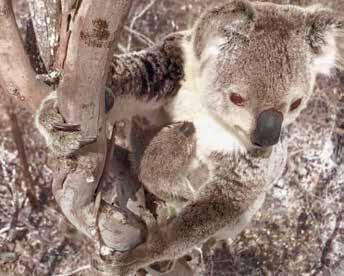
4 minute read
our furry friends post-bushfire
The most unlikely survivors KATHERINE SAMPSON feature
When a devastating bushfire swept through Ravensbourne and its surrounding areas the wildlife who called this bushland their home had little hope of survival. It was almost two weeks before wildlife rescuers Judi and Brendon Gray and other wildlife rescuers could enter the ash-filled forest in search of survivors.
“I must admit the first few days we didn’t find anything alive,” Judi said
Once the first living creature, a koala, was found hopes were lifted, but it didn’t last long.
“The first koala they rescued was exciting, but he had to be put down,” says Judi.
In their search they were unable to find any living possums, gliders or macropods, such as kangaroos and wallabies.
Judi was most concerned for the endangered brush tailed rock wallabies.
“They only have a small territory that they live in here,” she said. Bushfires bring death and destruction; but from the smoke emerge the stories of the victims who could only cling to one another until the danger had passed.
FROM LEFT: PENNY BEFORE HER RESCUE AFTER PECHEY HAMPTON FIRES (PHOTO BY BRENDON GRAY), PENNY’S NATURALLY DARK FUR AMAZED EVERYONE.


“With some of the properties that we’ve gone to check on the wildlife, there has been a large number of different species of macropods coming to drink from the water troughs,” says Judi.
“A lot of properties we’ve been able to get donations of macropod pellets and grain to put out so they can feed them.”
The need for wildlife carers is far from over as bushfires continue to burn across the country in the longest and most severe fire season in recorded history.
Scientists anticipate this deadly season to continue and become more severe under climate change.
Judi Gray advises if you find an injured, sick or burnt creature, the first thing is to ensuree its safety and pick it up and put it in a towel.
Then, or alternatively, call the RSPCA’s emergency hotline on 1300 ANIMAL to be directed to appropriate carers. feature “I haven’t talked to the rangers since, but hopefully they’ve seen some, and that they’ve survived.
“I must admit we did really hope that we might have found some of them.
“They have rock caves which are there but in the hills and where all those caves are was totally burnt up.”
Judi described these days as depressing, until finally the RSPCA had good news.
“We had a couple that we had rescued, and the RSPCA said yes we can treat these, it was a bit of a morale booster, and we all got excited again.”
On their own, the Gray’s rescued a total of 19 koalas, but their injuries were just too much with a mere five surviving.
Out of the five, a mother and her joey were found on a private property and a second female was found only a short distance away.
“That day we rescued six koalas, it was massive day and we couldn’t have done it without the Toowoomba Regional Council cherry picker driver.
“His name was Kevin and that’s who I named the baby after,” says Judi.
Mother Mia and her joey Kevin Jnr were found cuddling, but to the untrained eye it simply looked like one koala.
The other female, Penny, was found near the Cresbrook section of the fire-ravaged bushland.
“When we saw her, she was in an extraordinarily burnt location, “She was all singed and I burst into tears when I saw her up at the top of the tree because I thought she was completely burnt because of how black she was,” says Judi.
It wasn’t until the RSPCA had checked over Penny that she was in a better condition than initially thought.
“She is singed but that black charcoal colour is her natural colouring,” the vet said.
Penny wasn’t just amazing for her colour, she also had a twoday-old joey in her pouch.
“This means she gave birth after the fires when she was starving, at the top of that burnt tree.
“That little baby has somehow managed to climb up into the pouch with all Penny’s singed fur,” says Judi.
Judi has found the koala to have survived more than any other animal from the fires.
“They went to the very top of the trees and a lot of the trees are enormous.
“They were then singed or burnt and then starving.
When it came to the actual rescue, a method of flagging the koalas down, which involves a stick with something noisy at the top is held above the animal and they climb down on their own, was useless.
“It wouldn’t work, they were just so scared,” Judi says.
“It normally works for most rescues, but they were so scared, and they were crying.”
Those that remain in the bush, or more correctly the charred remains, haven’t been forgotten. CLOCKWISE FROM TOP: MIA AND KEVIN JNR LOOKING HEALTHY AND HAPPY, MIA AND KEVIN JNR DURING CHERRY PICKER RESCUE (PHOTO BY JUDI GRAY), JUDI GRAY & ORPHAN JOEY HENRY. “I burst into tears when I saw her up at the top of the tree because I thought she was completely burnt” JUDI GRAY















